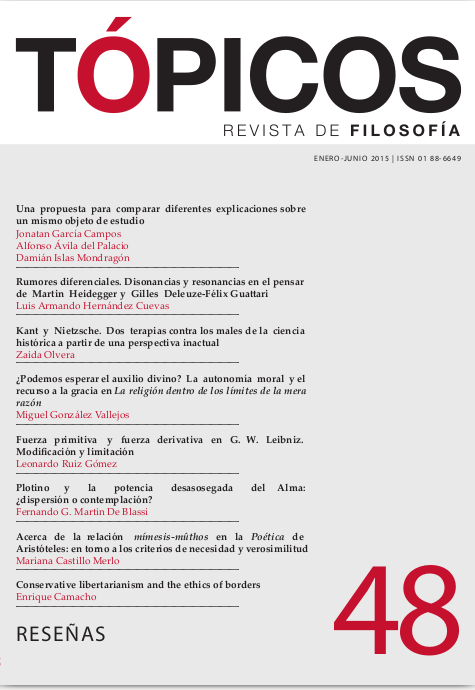Artículos
Publicado 2015-06-08
Palabras clave
- explicación,
- virtudes,
- autismo,
- origen de los números
Cómo citar
Campos, J. G., del Palacio, A. Ávila, & Mondragón, D. I. (2015). UNA PROPUESTA PARA COMPARAR DIFERENTES EXPLICACIONES SOBRE UN MISMO OBJETO DE ESTUDIO. Tópicos, Revista De Filosofía, 48, 9-44. https://doi.org/10.21555/top.v0i48.675
Resumen
Este trabajo propone una herramienta teórica con la que es posible comparar diferentes explicaciones dirigidas a un mismo objeto de estudio. Esta herramienta se compone de tres conjuntos de virtudes: epistémicas, analíticas y pragmáticas. Para apoyar lo anterior se ofrecen dos estudios de caso, el primero compara dos explicaciones psicológicas sobre el espectro autista, el segundo compara dos explicaciones sobre el origen de los números desde una perspectiva empiristaReferencias
- Ávila, A. (2011), The Natural Numbers Seen Philosophically. Lap Lambert: Saarbrücken, Germany.
- Balzer, W., Moulines, U. and Sneed, J. (1987), An architectonic for Science, Reidel Publishing: Dordrecht, Holland. Versión española de Pablo Lorenzano, Universidad Nacional de Quilmes Editorial, Bernal, 2012.
- Baron-Cohen, S., Leslie, A. and Uta, F. (1985), “Does the autistic child have a “theory of mind”?”, Cognition, 21: 37-46.
- Baron-Cohen, S. (2009), “Autism: The empathizing-systemizing (E-S) theory”, Annals of New York Academy of Sciences, 1156: 68-80.
- Braithwaite, R. (1953), Scientific Explanation, Cambridge, Cambridge University Press: Cambridge, UK.
- Butterworth, B. (1999), Mathematical Brain, The Free Press: New York, USA.
- Dehaene, S. (1997), The Number Sense, Oxford University Press: New York, USA.
- Frith, U. (2008), Autism, Oxford University Press: Oxford, UK.
- Frith, U. (2010), “Asperger and his syndrome”, in Frith U. (ed.), Autism and Asperger syndrome, Cambridge University Press: Cambridge, UK, pp. 1-36.
- Gallagher, S. (2004), “Understanding interpersonal problems in autism: interaction theory as an alternative to theory of mind”, Philosophy, Psychiatry, and Psychology, 11: 199-217.
- Gardiner, P. (ed.) (1952), Theories of History, The Free Press: New York, USA.
- Gardiner, P. (1959), The Nature of Historical Explanation, Oxford University Press: Oxford, UK.
- Golan, O. et. al. (2010), “Enhancing emotion recognition in children with autism spectrum conditions: an intervention using animated vehicles with real emotional faces”, Journal of Autism Developmental Disorder, 40: 269-279.
- Hempel, C. (1942), “The function of general laws in history”, Journal of Philosophy, 39: 35-48.
- Hempel, C. (1965), Aspects of Scientific Explanation and Other Essays in the Philosophy of Science, The Free Press: New York, USA.
- Hempel, C. and Oppenheim, P. (1948), “Studies in the logic of explanation”, Philosophy of Science, 15: 135–175.
- Kitcher, P. (1989), “Explanatory Unification and the Causal Structure of the World”, in Kitcher P. and Salmon W. (eds.), Scientific Explanation, University of Minnesota Press: Minneapolis, USA, pp. 410-505.
- Kolm, S. C. (1968), “Leon Walras correspondence and related papers,” American Economic Review, 58:1330-41.
- Kuhn, T. (1962), The Structure of Scientific Revolutions, Chicago University Press: Chicago, USA.
- Kuhn, T. (1977), The Essential Tension: Selected Studies in the Scientific Tradition and Change, Chicago University Press: Chicago, USA.
- Lakatos, I. (1976) Pruebas y refutaciones: la lógica del descubrimiento matemático. Versión española de Carlos Solís, Alianza Editorial, Madrid, España.
- Lakoff, G. and Núñez, R. (2000), Where Mathematics Comes From, Basic Books: New York, USA.
- Laudan, L. (1984), Science and values, University of California Press: Los Angeles, USA.
- Martínez, S. (2003), Geografía de las prácticas científicas: Racionalidad, heurística y normatividad, IIF-UNAM: México, México.
- Moulines, C.U. (1982) Exploraciones metacientíficas, Alianza Editorial, Madrid, España.
- Newton, I. (1687), Principios matemáticos de la filosofía natural y su sistema del mundo, edición de Antonio Escohotado, Madrid, España, Editora Nacional 1982.
- Popper, K. (1959), The Logic of Scientific Discovery, Hutchinson: London, UK.
- Schmandt-Besserat, D. (1992), Before Writing, University of Texas: Austin, USA.
- Salmon, W. (1984), Scientific Explanation and the Causal Structure of the World, Princeton University Press: Princeton, USA.
- Van Fraassen, B. (1996), La imagen científica, trad. Sergio Martínez, Paidós / Instituto de Investigaciones Filosóficas-UNAM: México, México.
- Walras, L. (1954), Elements of Pure Economics, trad. William Jaffé, Orion Editions: Philadelphia, USA.
- Woodward, J. (2003), Making Things Happen: a Theory of Causal Explanation, Oxford University Press: New York, USA.






